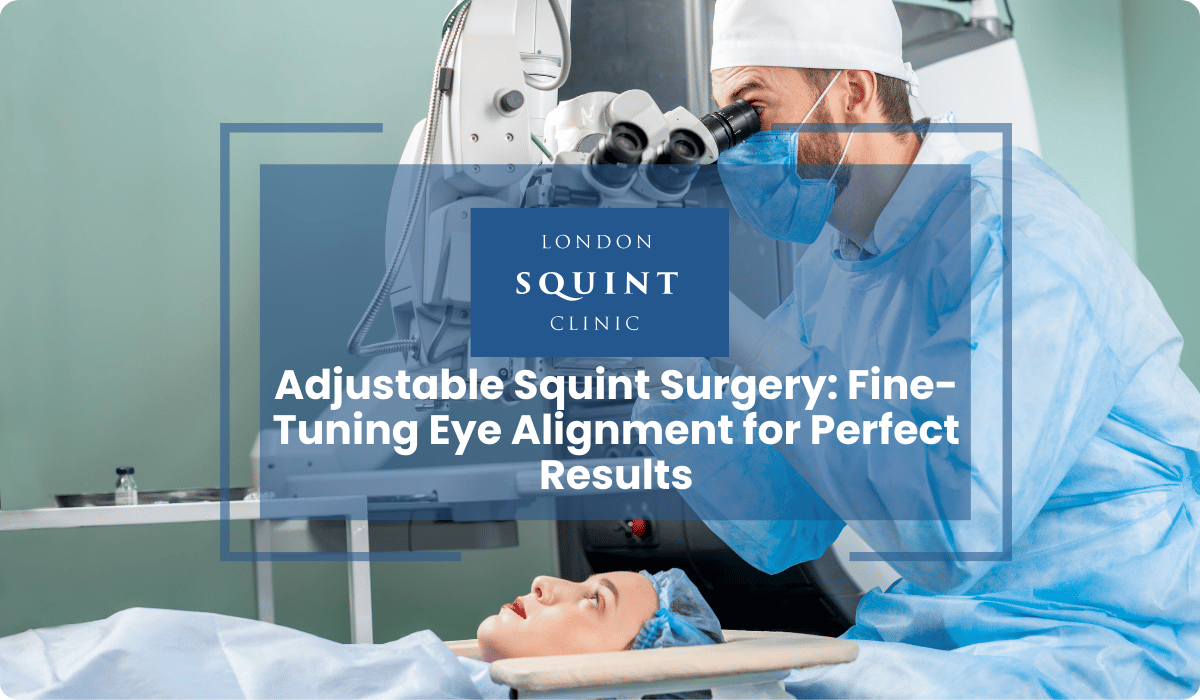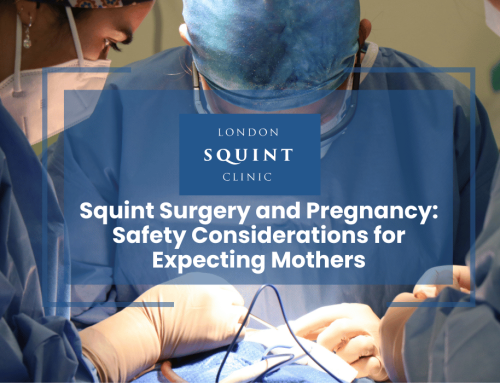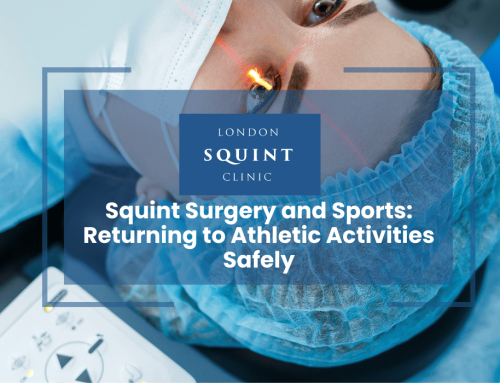Adjustable Squint Surgery: Fine-Tuning Eye Alignment for Perfect Results
Essential Insights: Why Adjustable Squint Surgery Matters
Enhanced Precision: Adjustable suture techniques allow for fine-tuning of eye alignment after the main surgery, offering superior precision compared to conventional methods.
Higher Success Rates: Clinical evidence shows 80-85% success with adjustable techniques versus 65-70% with conventional approaches, with even greater differences in complex cases.
Ideal for Adults: Particularly beneficial for adult patients with diplopia, complex strabismus, or those undergoing re-operations after previous unsuccessful surgery.
Patient Participation: The adjustment process involves active patient feedback while awake, allowing alignment to be optimized based on actual visual function rather than estimates.
Long-term Benefits: Patients who undergo adjustable surgery are less likely to require additional surgical interventions, resulting in better long-term outcomes and quality of life.
Table of Contents
- Understanding Adjustable Squint Surgery: A Modern Approach
- How Does the Adjustable Suture Technique Actually Work?
- Benefits of Choosing Adjustable Over Standard Squint Surgery
- The Patient Journey: Before, During and After Adjustment
- Precision Matters: Achieving Optimal Eye Alignment Results
- Who Makes an Ideal Candidate for Adjustable Suture Surgery?
- Recovery Timeline and Post-Adjustment Care Guidelines
- Comparing Success Rates: The Evidence Behind Adjustable Surgery
Understanding Adjustable Squint Surgery: A Modern Approach
Adjustable squint surgery represents one of the most significant advancements in strabismus treatment over the past few decades. Unlike conventional squint surgery where the eye muscles are repositioned and secured in a fixed position during the operation, adjustable suture techniques allow for fine-tuning of the eye alignment after the main surgical procedure has been completed.
This innovative approach addresses one of the fundamental challenges in squint correction: the unpredictability of healing responses. Each patient’s eyes respond differently to muscle repositioning, and factors such as muscle elasticity, scarring tendencies, and individual healing patterns can affect the final alignment outcome. The adjustable suture technique provides ophthalmologists with a second opportunity to refine the eye position once the initial effects of anaesthesia have worn off and the patient is fully conscious.
At London Squint Clinic, we specialise in this advanced surgical technique, offering patients the highest probability of achieving optimal alignment. The procedure is particularly valuable for complex cases, re-operations, and adult strabismus where precise alignment is crucial for eliminating double vision and achieving satisfactory cosmetic results.
How Does the Adjustable Suture Technique Actually Work?
The adjustable suture technique involves a two-stage process that allows for precise fine-tuning of eye alignment. During the initial surgery, the ophthalmologist detaches and repositions the relevant eye muscles, similar to standard squint surgery. However, instead of permanently securing these muscles in their new position, they are temporarily held in place with adjustable sutures—special stitches that can be manipulated later.
These sutures are carefully arranged in a bow-tie or slip-knot configuration that allows for subsequent adjustment. The ends of these sutures are left accessible at the surface of the eye, typically hidden beneath the eyelid. After the patient has fully recovered from anaesthesia—usually several hours after surgery or sometimes the following day—the adjustment phase begins.
During this critical second stage, the surgeon evaluates the patient’s eye alignment while they are awake and able to focus normally. Using topical anaesthetic drops to ensure comfort, the surgeon can then access the adjustable sutures and make precise modifications by either tightening or loosening them. This allows for real-time customisation of the eye position based on the patient’s actual visual function rather than estimations made during surgery.
The adjustment process typically takes 15-30 minutes and is performed with the patient sitting upright. Once optimal alignment is achieved, the sutures are permanently secured, and any excess suture material is trimmed away. This technique essentially provides a “preview” of the surgical outcome with the opportunity for refinement before finalising the result.
Benefits of Choosing Adjustable Over Standard Squint Surgery
Opting for adjustable suture surgery offers several significant advantages over conventional squint surgery techniques. The foremost benefit is the enhanced precision in achieving optimal eye alignment. By allowing post-operative adjustments while the patient is awake and able to use their vision normally, surgeons can fine-tune the eye position to address both the cosmetic appearance and functional aspects of vision.
This precision is particularly valuable for patients with complex strabismus conditions, including those with unpredictable muscle function, previous failed surgeries, or thyroid eye disease. The adjustable technique provides a safety net against under-corrections or over-corrections that might otherwise require a second operation to resolve.
Another key advantage is the potential for better binocular vision outcomes. By making adjustments based on the patient’s actual visual experience rather than measurements taken under anaesthesia, surgeons can optimise the alignment for fusion—the brain’s ability to blend images from both eyes into a single, three-dimensional perception. This can significantly improve depth perception and eliminate troublesome double vision.
For adult patients with longstanding squints who have developed compensatory head postures or those suffering from diplopia (double vision), the adjustable technique offers a higher probability of achieving comfortable, single vision without the need for prisms or further interventions. Understanding the fundamentals of squint surgery helps patients appreciate why this advanced technique represents the gold standard for many strabismus cases.
The Patient Journey: Before, During and After Adjustment
The patient experience with adjustable squint surgery follows a carefully structured pathway designed to ensure comfort, clarity, and optimal results. Before surgery, patients undergo comprehensive assessment including detailed measurements of their squint in different gaze positions, evaluation of eye movements, and discussion of visual symptoms. The surgeon will explain the adjustable technique and set realistic expectations about the adjustment process.
On the day of surgery, the procedure typically begins with either general anaesthesia or local anaesthesia with sedation, depending on patient factors and surgeon preference. The main surgical procedure involves detaching, repositioning, and securing the relevant eye muscles with the special adjustable sutures. This portion usually takes 45-60 minutes.
After recovery from anaesthesia, patients are prepared for the adjustment phase. This crucial step occurs when patients are fully alert—typically 4-6 hours after surgery or sometimes the following morning. Numbing eye drops ensure the adjustment process is comfortable. Patients sit upright while the surgeon evaluates their eye alignment, asking them to focus on targets at various distances and directions.
During adjustment, patients may experience brief sensations of pressure or movement as the sutures are manipulated, but the process is not painful. They actively participate by reporting their visual experience, particularly whether they see single or double images. This real-time feedback is invaluable for achieving the best possible alignment.
Once optimal positioning is achieved, the sutures are permanently secured, and patients can typically go home the same day. Many patients describe a sense of relief and satisfaction immediately following the adjustment, as they can often appreciate improvements in their vision and appearance right away.
Precision Matters: Achieving Optimal Eye Alignment Results
The pursuit of perfect eye alignment in squint surgery is not merely a cosmetic concern—it directly impacts visual function, comfort, and quality of life. Precision in alignment matters significantly because even small deviations can result in persistent double vision, visual strain, or the need for compensatory head postures. The adjustable suture technique represents the pinnacle of precision in strabismus surgery.
Traditional non-adjustable surgery relies heavily on measurements taken before and during surgery, with the surgeon making a calculated decision about exactly how much to move each muscle. However, these calculations cannot account for individual variations in healing, muscle elasticity, or the eye’s response to manipulation. The margin for error is relatively small—as little as 1-2 millimetres of muscle adjustment can make the difference between successful alignment and troublesome residual misalignment.
With adjustable sutures, the surgeon gains the ability to fine-tune the eye position with sub-millimetre precision while the patient is awake and using their vision normally. This level of precision is particularly crucial for adults with acquired strabismus or those seeking to eliminate double vision, where even minor misalignments can cause significant visual symptoms.
The technical expertise required for successful adjustable suture surgery is considerable. It demands not only surgical skill but also the ability to interpret complex measurements, understand the biomechanics of eye movements, and make nuanced adjustments based on both objective measurements and subjective patient feedback. At specialist centres like London Squint Clinic, surgeons have developed refined techniques that maximise the precision possible with adjustable sutures, leading to superior outcomes in challenging cases.
Who Makes an Ideal Candidate for Adjustable Suture Surgery?
While adjustable suture techniques offer significant advantages, they are particularly beneficial for specific patient groups. Adult patients generally make excellent candidates for adjustable surgery as they can cooperate fully during the adjustment phase, providing valuable feedback about their visual experience. This is especially important for patients with diplopia (double vision), where precise alignment is necessary to achieve comfortable single vision.
Patients with complex or unpredictable strabismus conditions stand to benefit significantly from the adjustable approach. These include individuals with thyroid eye disease, myasthenia gravis, or other conditions where muscle function may be variable or difficult to predict. Similarly, patients undergoing re-operation after previous unsuccessful squint surgery are prime candidates, as scar tissue and altered muscle dynamics make outcomes less predictable with standard techniques.
Those with incomitant strabismus—where the degree of misalignment varies depending on the direction of gaze—often achieve better results with adjustable surgery. The ability to test alignment in different gaze positions during the adjustment phase allows for optimisation across the visual field rather than just in the primary position.
Conversely, young children typically are not suitable candidates for adjustable suture techniques as they may not cooperate reliably during the adjustment phase. Patients with significant anxiety disorders or those unable to tolerate the adjustment process while awake may also be better served by conventional techniques. Additionally, certain types of complex strabismus involving restricted eye movements might have limitations with the adjustable approach.
A thorough pre-operative assessment by an experienced strabismus surgeon is essential to determine whether adjustable suture surgery is the optimal approach for each individual patient’s specific condition and circumstances.
Recovery Timeline and Post-Adjustment Care Guidelines
Following adjustable squint surgery, patients can expect a structured recovery process with several distinct phases. Immediately after the adjustment procedure, most patients experience immediate improvement in alignment, though some temporary discomfort, redness, and mild swelling are normal. The eyes may feel gritty or irritated for the first 48-72 hours, and artificial tears are typically recommended to alleviate this sensation.
During the first week, patients should avoid heavy lifting, strenuous exercise, swimming, and activities that might expose the eyes to dust or irritants. Sleeping with the head slightly elevated can help reduce swelling. Antibiotic and anti-inflammatory eye drops are usually prescribed for 1-2 weeks to prevent infection and control inflammation. Most patients can return to desk-based work within 3-5 days, though those with physically demanding jobs may need 10-14 days off.
By weeks 2-3, external redness and swelling typically subside significantly. Vision stabilises for most patients during this period, though some may experience fluctuations in alignment as the muscles adapt to their new positions. Driving can usually be resumed once comfortable single vision is established and confirmed at a follow-up appointment.
Full healing of the muscles and surrounding tissues takes approximately 6-8 weeks. During this time, the final alignment gradually settles. Most patients attend follow-up appointments at 1 week, 1 month, and 3 months post-surgery to monitor progress and address any concerns.
It’s important to note that while the adjustable technique provides excellent initial alignment, a small percentage of patients may experience some drift in alignment over time as tissues heal and adapt. This is typically minimal compared to standard techniques, but patients should be aware that perfect alignment might evolve slightly during the recovery period.
Comparing Success Rates: The Evidence Behind Adjustable Surgery
The scientific evidence supporting adjustable suture techniques in squint surgery is substantial and continues to grow. Multiple clinical studies have demonstrated superior outcomes with adjustable sutures compared to conventional fixed-suture approaches, particularly in complex adult strabismus cases. A comprehensive meta-analysis published in the British Journal of Ophthalmology found that adjustable suture surgery achieved successful alignment in 80-85% of cases, compared to 65-70% with conventional techniques.
For specific conditions such as thyroid eye disease-related strabismus, the difference is even more pronounced. Research indicates success rates approaching 90% with adjustable techniques versus approximately 60% with standard approaches. Similarly, in re-operation cases following previous unsuccessful surgery, adjustable sutures have demonstrated success rates of 75-80% compared to 50-55% with fixed sutures.
The benefits extend beyond initial success rates to long-term stability of alignment. A longitudinal study tracking patients over five years found that those who underwent adjustable suture surgery were significantly less likely to require additional surgical intervention compared to those who had conventional surgery. This translates to fewer operations, reduced healthcare costs, and less disruption to patients’ lives.
At London Squint Clinic, our internal audit data aligns with these published findings, with our adjustable suture techniques achieving successful alignment in over 85% of complex adult strabismus cases. For patients with diplopia (double vision), our functional success rate—defined as comfortable single vision in primary position and reading gaze—exceeds 90% with adjustable techniques.
While no surgical technique can guarantee perfect results in every case, the evidence clearly indicates that adjustable suture surgery offers the highest probability of successful alignment, particularly for adult patients and those with complex or previously operated strabismus. This evidence-based approach forms the foundation of our surgical practice and informs our recommendations to patients considering squint correction.
Frequently Asked Questions
Is adjustable squint surgery more painful than standard squint surgery?
No, adjustable squint surgery is not more painful than standard surgery. The main surgical procedure is performed under anesthesia just like standard surgery. During the adjustment phase, numbing eye drops ensure comfort. Patients may feel brief pressure or movement sensations during adjustments, but the process is designed to be pain-free. Most patients report the adjustment procedure is much more comfortable than they anticipated.
How long does the adjustment procedure take after the main surgery?
The adjustment procedure typically takes 15-30 minutes. It’s performed when patients are fully alert, usually 4-6 hours after the main surgery or sometimes the following morning. The exact timing depends on how quickly the patient recovers from anesthesia and the surgeon’s protocol. The adjustment is done with the patient sitting upright and involves real-time evaluation of eye alignment while making precise suture modifications.
What happens if I can’t cooperate during the adjustment phase?
If a patient cannot cooperate during the adjustment phase due to anxiety or discomfort, the surgeon can secure the adjustable sutures in their current position without making changes. Alternatively, minimal adjustments might be made based on objective measurements rather than subjective feedback. In cases where cooperation is anticipated to be difficult, your surgeon might recommend conventional non-adjustable surgery instead. This is one reason why pre-operative assessment and discussion are so important.
Can children have adjustable squint surgery?
Most young children are not suitable candidates for adjustable squint surgery as they typically cannot cooperate reliably during the conscious adjustment phase. However, older teenagers (usually 14+ years) who demonstrate sufficient maturity and understanding may be considered for the procedure. For younger children, conventional non-adjustable techniques remain the standard approach and can still achieve excellent results when performed by experienced surgeons.
What is the success rate of adjustable squint surgery compared to standard techniques?
Research shows adjustable squint surgery achieves successful alignment in 80-85% of cases, compared to 65-70% with conventional techniques. For complex cases like thyroid eye disease-related strabismus, success rates approach 90% with adjustable techniques versus approximately 60% with standard approaches. Re-operation cases show 75-80% success with adjustable sutures compared to 50-55% with fixed sutures. Adjustable techniques also demonstrate better long-term stability, reducing the need for additional surgeries.
How soon after adjustable surgery can I return to normal activities?
Most patients can return to desk-based work within 3-5 days after adjustable squint surgery. Driving can usually be resumed once comfortable single vision is established, typically within 1-2 weeks. Swimming should be avoided for 2-3 weeks, and contact sports for 4-6 weeks. Complete healing of muscles and tissues takes approximately 6-8 weeks, though vision and alignment typically stabilize much sooner. Your surgeon will provide personalized guidance based on your specific procedure and recovery progress.
Find out if you are suitable for Double Vision Treatment
Not everyone is eligible for double vision surgery.
Find out if you could benefit from this life-changing surgery by taking the quick self-suitability quiz below:
Our most popular procedures

Hello, I’m Nadeem Ali
I’m one of the few eye surgeons in the world with 100% focus on Squint and Double Vision Surgery.
I have 24 years of eye surgery experience, and worked for 13 years as a Consultant at London’s renowned Moorfields Eye Hospital.
In 2023, I left the NHS to focus fully on treating patients from across the world at the London Squint Clinic. You can read more about me here.
There’s lots of information on the website about: squint surgery, double vision surgery and our pricing.
The most rewarding part of my job is hearing patients tell me how squint or double vision surgery has changed their lives. You can hear these stories here.
Mr Nadeem Ali
MA MB BChir MRCOphth FRCSEd(Ophth)





